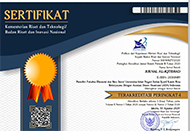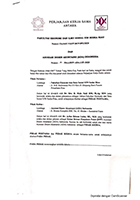USING THE THEORY OF PLANNED BEHAVIOR IN ACCOUNTING RESEARCH: A BIBLIOMETRIC REVIEW
Abstract
Keywords
Full Text:
PDFReferences
Afdalia, N., Pontoh, G. T., & Kartini, K. (2014). Theory of planned behavior dan readiness for change dalam memprediksi niat implementasi peraturan pemerintah nomor 71 tahun 2010. Jurnal Akuntansi & Auditing Indonesia, 18(2), 110–123. https://doi.org/10.20885/jaai.vol18.iss2.art3
Ajzen. I., & Fishbein, M. (1980). Understanding Attitudes and Predicting Social Behavior. In Englewood Cliff (Pbk. ed). Prentice-Hall.
Ajzen, I., & Driver, B. L. (1991). Prediction of leisure participation from behavioral, normative, and control beliefs: An application of the theory of planned behavior. Leisure Sciences, 13(3), 185–204. https://doi.org/10.1080/01490409109513137
Ajzen, I., & Fishbein, M. (1969). The prediction of behavioral intentions in a choice situation. Journal of Experimental Social Psychology, 5(4), 400–416. https://doi.org/10.1016/0022-1031(69)90033-X
Ajzen, I., & Fishbein, M. (2005). The Influence of Attitudes on Behavior. In D. Albarracin, B. T. Johnson, & M. P. Zanna (Eds.), The Handbook of Attitudes (Vol. 173, Issue 221). Mahwah, NJ: Lawrence Erlbaum Associates.
Ajzen, I., & Madden, T. J. (1986). Prediction of goal-directed behavior: Attitudes, intentions, and perceived behavioral control. Journal of Experimental Social Psychology, 22(5), 453–474. https://doi.org/10.1016/0022-1031(86)90045-4
Albayrak, T., Aksoy, Ş., & Caber, M. (2013). The effect of environmental concern and scepticism on green purchase behaviour. Marketing Intelligence & Planning, 31(1), 27–39. https://doi.org/10.1108/02634501311292902
Asmoro, P. S., Aini, E. K., & Nurlaily, F. (2022). Tax Policy and Financial Access: Implications for Entrepreneurial Intention and Entrepreneurial Behavior Among Generation Z. Jurnal Akuntansi Dan Keuangan, 24(2), 57–67. https://doi.org/10.9744/jak.24.2.57-67
Bosnjak, M., Ajzen, I., & Schmidt, P. (2020). The theory of planned behavior: Selected recent advances and applications. Europe’s Journal of Psychology, 16(3), 352–356. https://doi.org/10.5964/ejop.v16i3.3107
Chaplin, J. . (1995). Kamus Lengkap Psikologi (ed. 1 cet.2). Raja Grafindo Persada.
Chiou, Jyh, S. (1998). The Effects of Attitude, Subjective Norm, and Perceived Behavioral Control on Consumers’ Purchase Intentions: The Moderating Effects of Product Knowledge and Attention to Social Comparison Information. Proc. Natl. Sci. Counc. ROC (C), 9(2), 298–308. https://www.semanticscholar.org/paper/The-Effects-of-Attitude-%2C-Subjective-Norm-%2C-and-on-Chiou/c5bf1e0f37b1bf1676886cfdcd54531bfeed793e
Conner, M., & Armitage, C. J. (1998). Extending the Theory of Planned Behavior: A Review and Avenues for Further Research. Journal of Applied Social Psychology, 28(15), 1429–1464. https://doi.org/10.1111/j.1559-1816.1998.tb01685.x
Fishbein, M., & Ajzen, I. (2010). Predicting and changing behavior: The reasoned action approach. In Psychology Press. Taylor & Francis Group.
Godin, G., Valois, P., & Lepage, L. (1993). The pattern of influence of perceived behavioral control upon exercising behavior: An application of Ajzen’s theory of planned behavior. Journal of Behavioral Medicine, 16(1), 81–102. https://doi.org/10.1007/BF00844756
Hakim, L. (2020). Analisis Bibliometrik penelitian inkubator bisnis pada publikasi ilmiah terindeks Scopus. Procuratio: Jurnal Ilmiah Manajemen, 8(2), 176–189. https://www.ejournal.pelitaindonesia.ac.id/ojs32/index.php/PROCURATIO/article/view/677
Han, H. (2015). Travelers’ pro-environmental behavior in a green lodging context: Converging value-belief-norm theory and the theory of planned behavior. Tourism Management, 47, 164–177. https://doi.org/10.1016/j.tourman.2014.09.014
Kolvereid, L. (1996). Prediction of Employment Status Choice Intentions. Entrepreneurship Theory and Practice, 21(1), 47–58. https://doi.org/10.1177/104225879602100104
Kouthouris, C., & Spontis, A. (2005). Outdoor Recreation Participation: An Application of the Theory of Planned Behavior. The Sport Journal, 8(3). https://www.cabdirect.org/cabdirect/abstract/20073156603
Lavuri, R., & Susandy, G. (2020). Green Products: Factors Exploring the Green Purchasing Behavior of South Indian Shoppers. Indonesian Journal of Sustainability Accounting and Management, 4(2), 174. https://doi.org/10.28992/ijsam.v4i2.229
Okun, M. A., & Sloane, E. S. (2002). APPLICATION OF PLANNED BEHAVIOR THEORY TO PREDICTING VOLUNTEER ENROLLMENT BY COLLEGE STUDENTS IN A CAMPUS-BASED PROGRAM. Social Behavior and Personality: An International Journal, 30(3), 243–249. https://doi.org/10.2224/sbp.2002.30.3.243
Palupi, D., & Santoso, B. H. (2017). An Empirical Study on the Theory of Planned Behavior: the Effect of Gender on Entrepreneurship Intention. Journal of Economics, Business & Accountancy Ventura, 20(1), 71. https://doi.org/10.14414/jebav.v20i1.626
Pangestu, I., & Jayanto, P. Y. (2017). Accounting Analysis Journal Analysis in Factors Affecting Muzakki Motivation to Pay Zakat in Semarang City. Accounting Analysis Journal, 6(1), 94–103. http://journal.unnes.ac.id/sju/index.php/aaj
Paul, J., Modi, A., & Patel, J. (2016). Predicting green product consumption using theory of planned behavior and reasoned action. Journal of Retailing and Consumer Services, 29, 123–134. https://doi.org/10.1016/j.jretconser.2015.11.006
Prabandari, S. P., & Sholihah, P. I. (2015). The influence of theory of planned behavior and entrepreneurship education towards entrepreneurial intention. Journal of Economics, Business & Accountancy Ventura, 17(3), 385. https://doi.org/10.14414/jebav.v17i3.360
Prastiwi, D., Narsa, I. M., & Tjaraka, H. (2019). Sintesis Sistem Akuntansi Perpajakan. Jurnal Akuntansi Multiparadigma, 10(2), 276–294. https://doi.org/10.18202/jamal.2019.08.10016
Ridwan, M., AM, S., Ulum, B., & Muhammad, F. (2021). Pentingnya Penerapan Literature Review pada Penelitian Ilmiah. Jurnal Masohi, 2(1), 42. https://doi.org/10.36339/jmas.v2i1.427
Rozi, F. (2020). Systematic Literature Review pada Analisis Prediktif dengan IoT: Tren Riset, Metode, dan Arsitektur. Jurnal Sistem Cerdas, 3(1), 43–53. https://doi.org/10.37396/jsc.v3i1.53
Suharso, P., Setyowati, L., & Arifah, M. N. (2021). Bibliometric Analysis Related to Mathematical Research through Database Dimensions. Journal of Physics: Conference Series, 1776(1), 012055. https://doi.org/10.1088/1742-6596/1776/1/012055
Urumsah, D., Wicaksono, A. P., & Pratama, A. J. P. (2016). Melihat jauh ke dalam: Dampak kecerdasan spiritual terhadap niat melakukan kecurangan. Jurnal Akuntansi & Auditing Indonesia, 20(1), 48–54. https://doi.org/10.20885/jaai.vol20.iss1.art5
Wandayu, R. C., Purnomosidhi, B., & Ghofar, A. (2019). Faktor Keperilakuan dan Perilaku Kecurangan Akademik: Peran Niat sebagai Variabel Mediasi. Riset Akuntansi Dan Keuangan Indonesia, 4(1), 89–100. https://doi.org/10.23917/reaksi.v4i1.7414
White, K. M., Smith, J. R., Terry, D. J., Greenslade, J. H., & McKimmie, B. M. (2009). Social influence in the theory of planned behaviour: The role of descriptive, injunctive, and in‐group norms. British Journal of Social Psychology, 48(1), 135–158. https://doi.org/10.1348/014466608X295207
Winardi, R. D., Mustikarini, A., & Anggraeni, M. A. (2017). ACADEMIC DISHONESTY AMONG ACCOUNTING STUDENTS: SOME INDONESIAN EVIDENCE. Jurnal Akuntansi Dan Keuangan Indonesia, 14(2), 142–164. https://doi.org/10.21002/jaki.2017.08
Yadav, R., & Pathak, G. S. (2016). Young consumers’ intention towards buying green products in a developing nation: Extending the theory of planned behavior. Journal of Cleaner Production, 135, 732–739. https://doi.org/10.1016/j.jclepro.2016.06.120
DOI: http://dx.doi.org/10.24014/jiq.v20i1.26697
Refbacks
- There are currently no refbacks.














